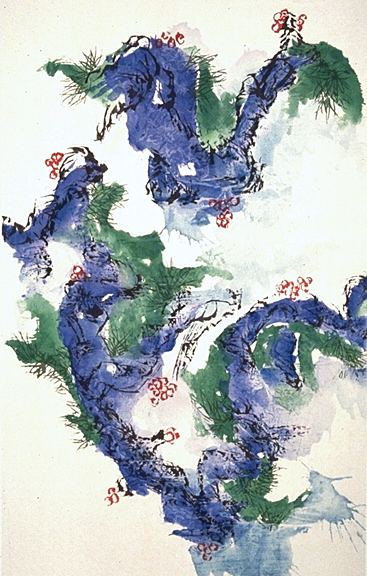Brad Davis uses mixed media, painting, and sculpture to depict themes of nature and landscape. His work is associated with the Pattern and Decoration movement of the 1980s. Davis shared a studio with Robert Kushner in New York City, where they were both represented by Holly Solomon Gallery. Arnold Chang describes Davis’s work in Orientations in 1993: “His landscapes and still lifes combine insights derived from the direct observation of nature with images gleaned from other art, both Eastern and Western, past and present.”
Davis was born in 1942 in Duluth, Minnesota. After graduating from the University of Minnesota in 1966, he moved to New York and began graduate work at Hunter College, where he studied Islamic art and Chinese painting. Davis felt that Chinese art “hit a spiritual note” and was particularly interested in “the breezy, light-hearted, imaginative painting” on Chinese porcelain. He often borrows images and patterns from Chinese ceramics to add into his own paintings. Davis’s wife, artist Janis Provisor, is also invested in Asian culture. After traveling throughout China in the 1990s, the couple settled in Hangzhou for a year. They rented a space that was organized into a temporary studio so that they could work on a woodblock project with Crown Point Press. Davis completed two color woodcut prints in the temporary studio: Transformations and Night Reflections – Ching Ming, both published in 1994. Transformations is a woodcut printed on silk mounted on rag paper; it represents a blue and green landscape that takes the shape of a swirling dragon. Night Reflections – Ching Ming is a woodcut printed on xuan zhi paper mounted on rag paper; it depicts a dark nighttime scene of festival lights mirrored in the West Lake of Hangzhou.
During their time in China, Davis and Provisor met with a manager of a silk carpet factory; Davis wanted a custom silk carpet for their loft in New York so they began creating small samples inspired by watercolor patterns. Their unique approach was met with resistance because the weavers couldn’t do what the couple was asking for. It took about two and half years for them to learn how to “weave a watercolor” David said, adding “they found that our patterns were actually easier to read than the traditional ones.” In 1997, Davis and Provisor founded the Fort Street Studio, a rug showroom specializing in luxurious hand-knotted carpets with painterly qualities, named after the street they lived on. They have exhibited their designs in Paris, London, and Milan. Fort Street Studio has showrooms located in New York, Los Angeles, and Hong Kong. Davis, Provisor, and their son lived in Hong Kong for nine years before returning to New York in 2002.
Brad Davis won the Individual Artists Grant from the National Endowment for the Arts in 1988. His work is held in the collections of the Metropolitan Museum of Art, the Whitney Museum of American Art, the Museum of Modern Art, the Denver Art Museum, the Nelson-Atkins Gallery, and the Walker Art Center. He has had solo exhibitions at Holly Solomon Gallery, New York, NY; Tavelli Gallery, Aspen, CO; Mayor Gallery, London, UK; and The Taft Museum, Cincinnati, OH. He lives and works in New York with his wife, Janis Provisor.
-Carleigh Koger

